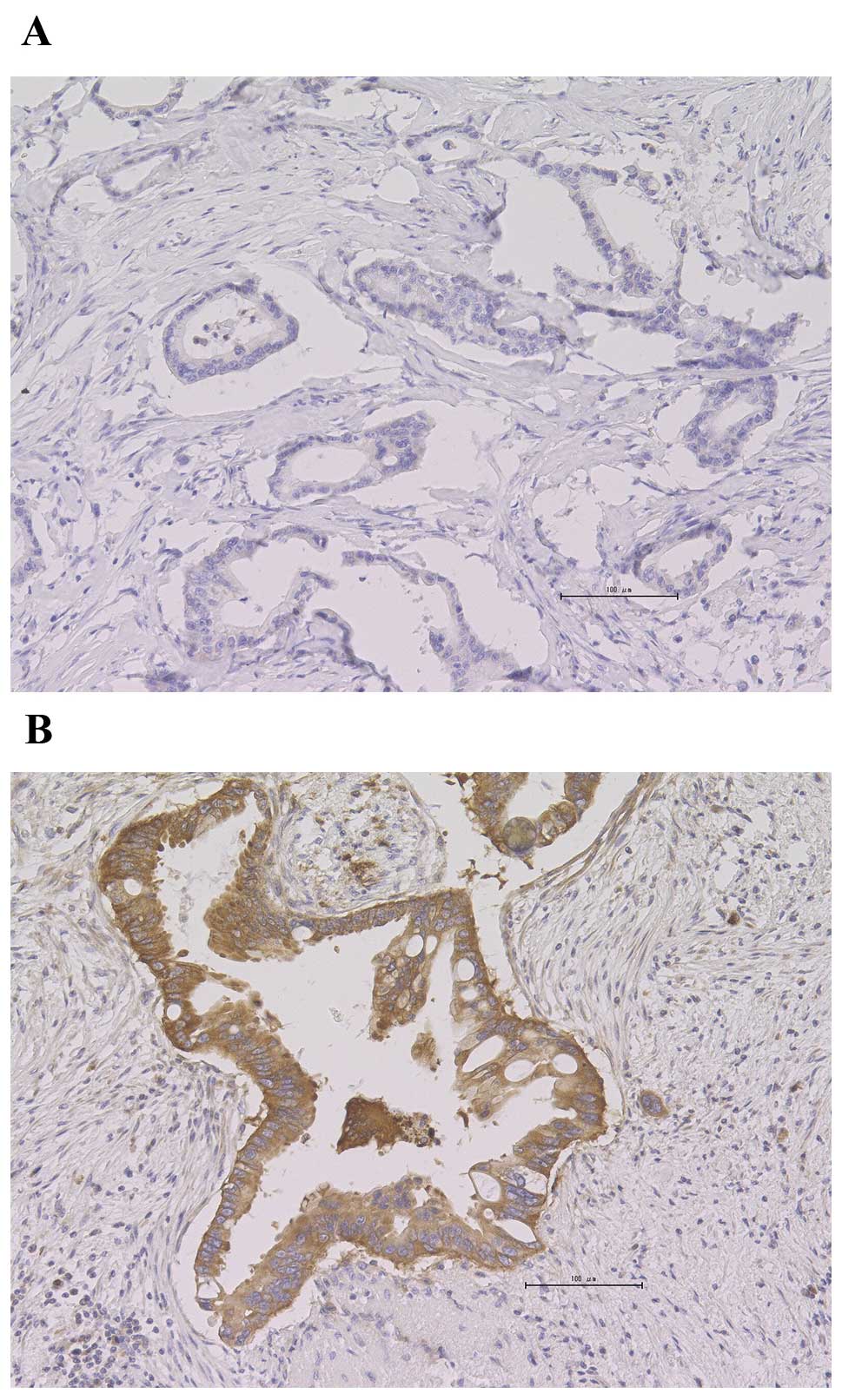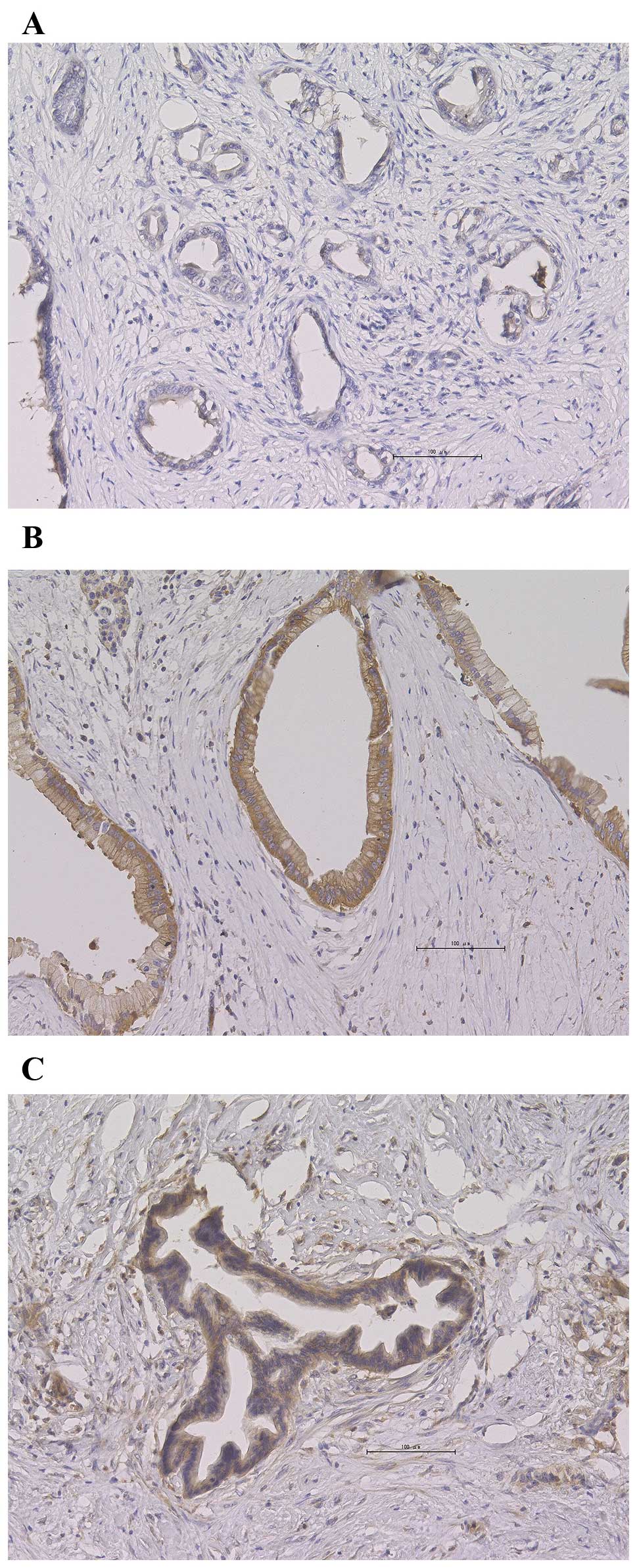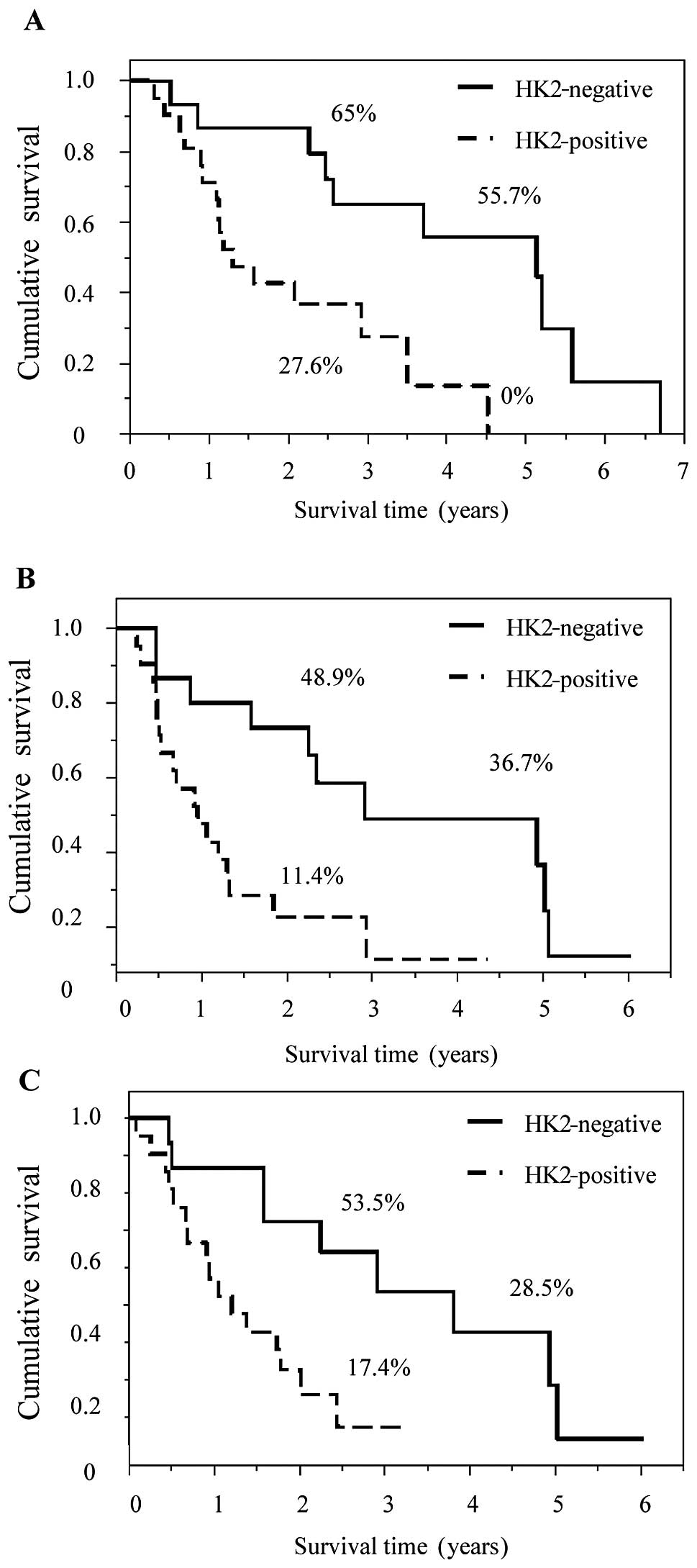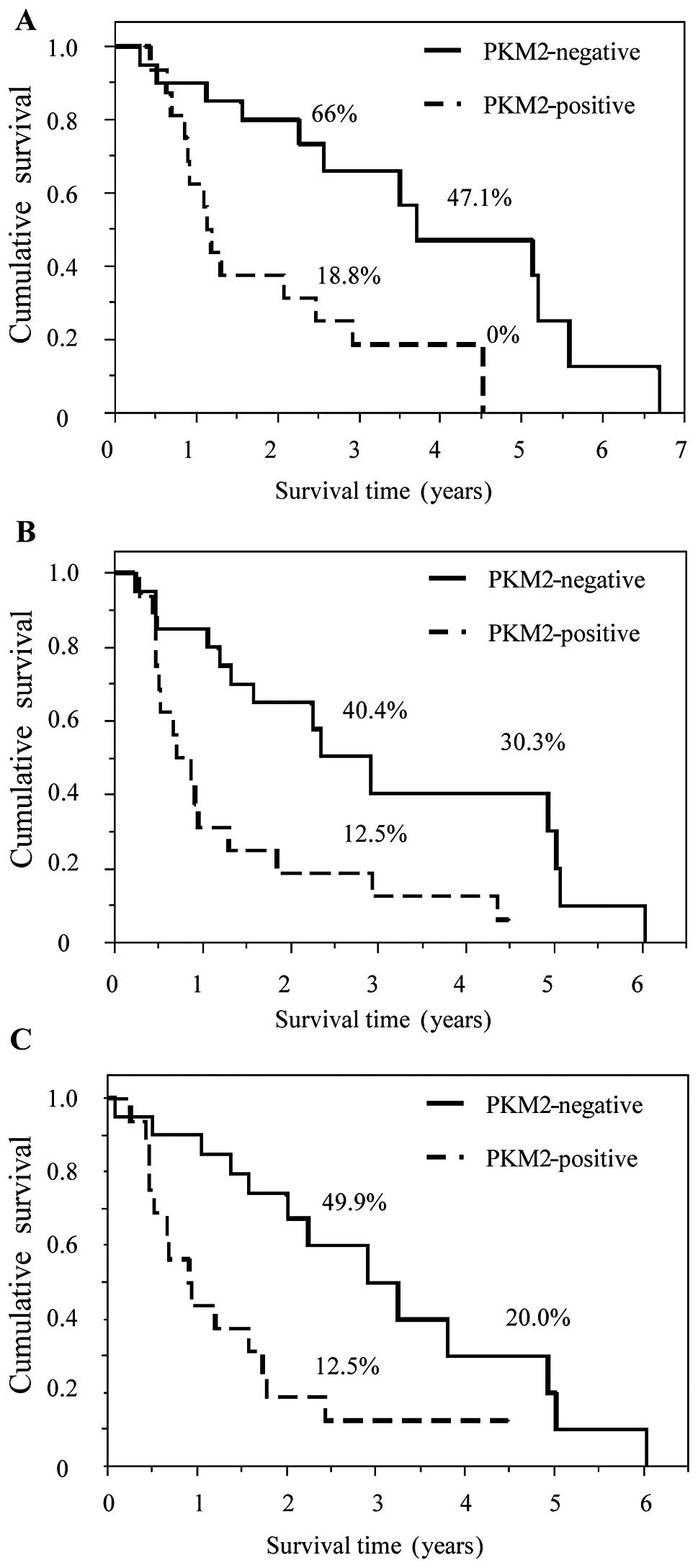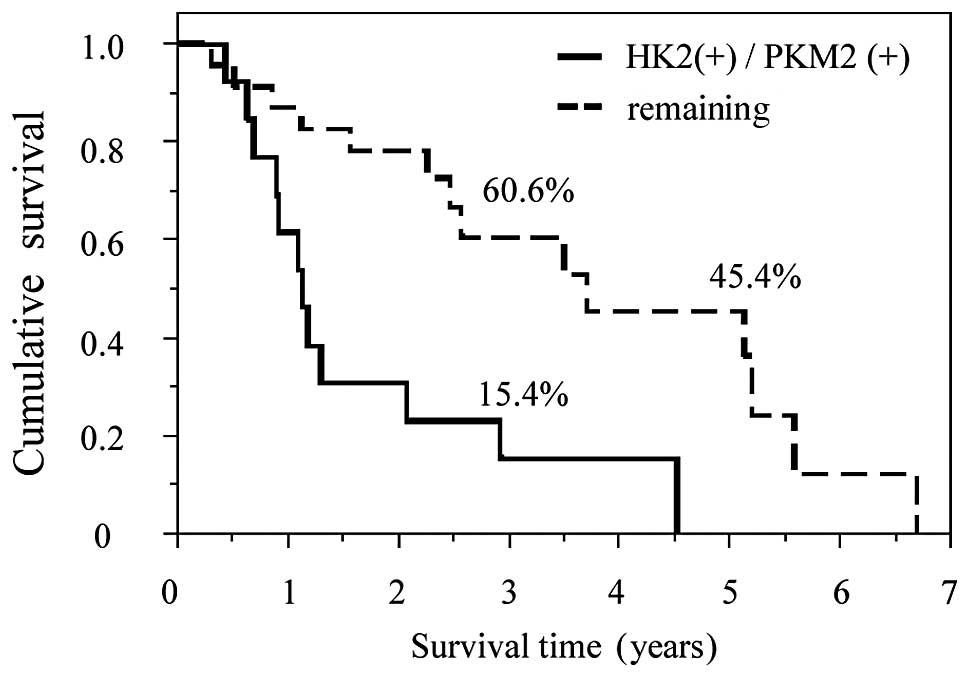The combination of the expression of hexokinase 2 and pyruvate kinase M2 is a prognostic marker in patients with pancreatic cancer
- Authors:
- Published online on: January 22, 2015 https://doi.org/10.3892/mco.2015.490
- Pages: 563-571
Abstract
Introduction
Pancreatic ductal carcinoma is a highly aggressive cancer, with one of the highest mortality rates among gastrointestinal cancers. The survival of patients with pancreatic ductal carcinoma has not improved significantly over the last 30 years; the 5-year survival rate was reported to be ∼6% (1).
Complete surgical resection for localized pancreatic ductal carcinoma is recommended as the only curative treatment option. However, due to the high incidence of locoregional recurrence (mainly in the pancreatic bed) and liver metastasis, the 5-year survival rate is ≤20% following curative surgical resection (2–6). The clinical benefit of preoperative chemoradiation (CRT) for better local control following surgical resection was recently reported (7,8). Moreover, in addition to preoperative CRT followed by curative resection, postoperative liver perfusion therapy may be efficient in reducing the incidence of liver metastasis (6,9). These findings suggest that pancreatic ductal carcinoma is a type of high-grade malignant tumor that requires multidisciplinary treatment for a complete cure. The identification of clinically useful predictive markers is necessary to maximize the therapeutic effect.
As regards clinical pathology, pancreatic cancer cells are mainly surrounded by a dense desmoplastic region consisting primarily of myofibroblasts as the main cellular component and extracellular matrix proteins (2). This desmoplastic change represents the key characteristic of pancreatic ductal carcinoma. Although the effect of the surrounding stromal cells on the malignant behavior of pancreatic cancer cells is controversial (3–5), the abundant fibrotic environment inhibits neovascularization. Hypovascularity may lead to the insufficient delivery of oxygen and nutrients to the tumor (6). Hypoxic tumors are associated with poor patient prognosis, due to hypoxia-mediated treatment resistance and hypoxia-induced biological changes that promote malignancy, including metastasis (7–10). Under such stressful hypoxic microenvironment conditions, cancer cells undergo a shift in cellular metabolism. This shift in energy production from oxidative phosphorylation to glycolysis, known as the Warburg effect, is a fundamental property of cancer cells (11).
Even under conditions of abundant oxygen supply, cancer cells preferably produce large amounts of lactate; therefore, cancer metabolism often involves aerobic glycolysis. Despite the inefficient adenosine 5′-triphosphate (ATP) production system in tumors, known as Warburg effect, cancer cells exhibit ATP production ability equivalent to that of normal cells by utilizing the glycolytic system, leading to the production of nucleic acids and nicotinamide adenine dinucleotide phosphate (12). During aerobic glycolysis, glucose is phosphorylated by hexokinase 2 (HK2) to form glucose-6-phosphate and lactic acid is produced from pyruvic acid by pyruvate kinase isoenzyme type M2 (PKM2).
Although the expression of HK2 and PKM2 were reported to be correlated with cancer cell growth (13,14), their role in pancreatic ductal carcinoma remains unclear. Several histopathological factors have been shown to predict postoperative prognosis in pancreatic ductal carcinoma (15–20). As a key regulator of aerobic glycolysis, the expression of HK2 and PKM2 is likely significant for the progression and prognosis of pancreatic ductal carcinoma, which is a classical hypoxic tumor. In the present study, we investigated the expression of HK2 and PKM2 in surgically resected specimens from patients with pancreatic ductal carcinoma using immunohistochemical staining. The correlation of HK2 and PKM2 expression with clinicopathological characteristics and prognosis was then investigated.
Patients and methods
Patients
Between 2007 and 2012, a total of 91 patients underwent curative surgical resection for pancreatic ductal carcinoma. The diagnosis was confirmed by a pathologist based on the cytology of the pancreatic juice and/or endoscopic ultrasound-guided fine-needle aspiration preoperatively. We have been performing preoperative CRT since 2007 with the aim of securing a curative margin to achieve better local control and survival in selected patients. However, to avoid the effect of preoperative treatment on immunohistochemical staining patterns, this study included 36 patients who underwent curative surgical resection without preoperative treatment, such as CRT or chemotherapy.
Clinical data were collected from patient medical records. Overall survival (OS), local recurrence-free survival (LRFS) and distant metastasis-free survival (DMFS) were calculated from the date of surgery to the occurrence of adverse events.
This study was approved by the ethics committee of the Graduate School of Medicine, Osaka University, for use of clinical samples. Prior to enrollment in this study, all the patients provided written informed consent, as required by the Osaka University Human Study Committee.
Immunohistochemical staining
All the samples were fixed using 10% neutral formalin and embedded in paraffin wax. Immunohistochemistry was performed on 3.5-µm paraffin-embedded sections cut from the main block. The sections were deparaffinized in Hemo-De (FALMA, Tokyo, Japan) and rehydrated in a graded ethanol series. Antigen retrieval was performed using citrate buffer (10 mM, pH 6.0) heated in a water bath for 40 min. The slides were blocked using goat serum for 20 min at room temperature, then incubated with monoclonal rabbit anti-human HK2 antibody (1:400; cat. no. 2867; Cell Signaling Technology, Danvers, MA, USA) or monoclonal anti-human PKM2 antibody (1:400; cat. no. 4053; Cell Signaling Technology) overnight at 4˚C. The Vectastain ABC Peroxidase kit (Vector Laboratories, Burlingame, CA, USA) was used to visualize the antigen and counterstaining was performed with hematoxylin. The staining intensity of HK2 and PKM2 was defined as negative (0), weak (+1), or strong (+2). The distribution of positively stained cells was scored on a scale of 0–5: 0, no staining; 1, <20%; 2, 20–40%; 3, 40–60%; 4, 60–80%; and 5, 80–100%. The total histological score was calculated as the staining intensity × distribution (score <5, negative expression and ≥5, strong expression). Parrafin-embedded sections of human normal liver and colon cancer tissue served as positive controls for HK2 and PKM2, respectively. Prognostic analyses were performed according for OS, LRFS and DMFS.
Statistical analysis
The Fisher's exact test and χ2 test were used to evaluate the association of HK2 and PKM2 expression with clinicopathological variables. The Kaplan-Meier method and the log-rank test were used to compare the survival rates among groups. The Cox proportional hazard model was used for univariate and multivariate survival analyses. P<0.05 was considered to indicate a statistically significant difference. All the analyses were performed using the JMP statistical software package, version 11 (SAS Institute, Cary, NC, USA).
Results
Patient characteristics
A total of 36 patients who underwent curative resection for pancreatic ductal carcinoma between 2007 and 2012 were included in this study. The patient demographics and clinical and surgical characteristics are summarized in Table I.
Table I.Demographics, clinical and surgical characteristics of patients with pancreatic adenocarcinoma. |
HK2
HK2-positive staining was detected in 58% (21/36) of the patients. HK2-positive tumor specimens exhibited predominantly cytoplasmic staining patterns, whereas the adjacent fibrotic tissue was stained negative (Fig. 1). However, there was heterogeneity regarding the HK2 staining pattern. HK2-positive staining was homogenous in 67% of the positive samples (14/21) and heterogeneous in 33% (7/21). The association between positive staining for HK2 and clinicopathological characteristics was investigated (Table II) and significant differences in HK2 staining were identified according to pathological tumor stage (P=0.017).
PKM2
PKM2-positive staining was detected in 44% (16/36) of the patients and was localized to the cytoplasm in 44% of the samples (7/16), whereas in the remaining samples it was localized in the nucleus as well as the cytoplasm. Representative staining images are shown in Fig. 2. PKM2-positive staining was predominantly distributed homogeneously. The association between staining for PKM2 and clinicohistopathological characteristics is presented in Table III. There was no significant difference in the clinicopathological variables between PKM2-positive and -negative patients.
Association between HK2 and PKM2 and prognosis
HK2- and PKM2-positive staining was significantly associated with poor prognosis. OS, LRFS and DMFS in patients with HK2- and PKM2-positive staining were statistically worse compared to those with negative staining (Figs. 3 and 4). In addition, staining for HK2 was significantly associated with staining for PKM2 (Table IV; P=0.01). The univariate analysis revealed that progressive pathological T stage (pT3 vs. pT1 and pT2; P=0.02), positive HK2 staining (P=0.003), positive PKM2 staining (P=0.004) and pathological nodal metastasis (P=0.003) were significantly associated with poor OS. In the multivariate analysis, pathological nodal metastasis was the only significant factor for OS [hazard ratio = 2.76, 95% confidence interval: 1.08–7.73] (Table V). Moreover, the combination of HK2 and PKM2 had a clear prognostic effect. The high expression of both HK2 and PKM2 was correlated with poor patient survival compared to the remaining groups, including high HK2 and low PKM2 expression, low HK2 and high PKM2 expression and low expression of both HK2 and PKM2 (MST, 1.13 vs. 3.71 years; P=0.0016). Among all groups, patients expressing high levels of HK2 as well as PKM2 exhibited the poorest prognosis (Fig. 5).
Discussion
To the best of our knowledge, this is the first study to describe the association between clinicopathological characteristics and the expression of HK2 and PKM2 in pancreatic ductal carcinoma. Pancreatic ductal carcinoma is characterized by the presence of abundant fibrotic tissue consisting of stromal cells, activated fibroblasts, stellate cells, immune cells and extracellular matrix components (2,21). These desmoplastic changes inhibit proper neovascularization, leading to a severe shortage of oxygen and nutrients (6). Under such conditions, pancreatic ductal carcinoma cells exhibit more aggressive malignant potential to ensure their survival. The malignant shift depends mainly on hypoxic-inducible factor-1 (HIF-1), which is the transcriptional activator of various genes associated with cell immortalization, genetic instability, glucose and energy metabolism, vascularization, invasion, metastasis and resistance to chemotherapy and radiotherapy (22–24). A hypoxic environment induces the expression of HIF-1, which subsequently activates the transcription of the glucose transporters (GLUT)-1 and −3, as well as HK1 and HK2, which are the first enzymes in glycolysis (23).
Previous studies demonstrated that numerous cancers display enhanced glucose uptake compared to normal tissues due to the overexpression of various GLUTs (25,26). Several studies have reported that the overexpression of GLUTs in cancer is associated with an unfavorable prognosis (27,32). In addition, abundant glucose uptake caused by GLUT overexpression in malignant tumors is immediately metabolized by HK2 and is then used for energy production (28,29). Tumor imaging using 18f-labeled 2-deoxyglucose positron emission tomography (FDG-PET) was developed to assess cancer metabolism (30). FDG-PET imaging utilizes the overexpression of HK2, which subsequently phosphorylates 18fdg to form fDG-6-phosphate in malignant cancer cells (31). However, under aerobic conditions, normal cells oxidize pyruvic acid, the end product of glycolysis, via oxidative phosphorylation to achieve a high yield of energy, thereby allowing tumors to be clinically diagnosed.
Unlike normal cells that use glycolysis only in the hypoxic state, cancer cells depend exclusively on glycolysis for energy production via PKM2, the rate-limiting glycolytic enzyme that catalyses the conversion of phosphoenolpyruvate to pyruvate, even in the presence of oxygen (32). This cancer-specific aerobic glycolysis is a less efficient pathway in terms of energy production.
Previous studies demonstrated that this metabolic shift is driven by the activation of genetic mutations including KRAS codon 12, INK4A/ARF, SMAD4/DPC4 and oncogenic signaling pathway genes (33–35). To compensate for the inefficient energy production system, cancer cells in a hypoxic environment yield large amounts of ATP by the high flux between glycolysis and oxidative phosphorylation in a feedback loop. Proliferating cancer cells require nucleotides, fatty acids and membranous lipids and proteins in addition to energy; PKM2 provides these substrates during glycolysis. The glycolytic intermediate upstream of phosphoenolpyruvate may then be used in synthetic processes. For example, NADPH may be derived from glucose-6-phosphate in the pentose phosphate pathway. NADPH contributes to fatty acid synthesis and, together with ribose-5-phosphate, to nucleotide synthesis (36). This enhanced production of substrates may be beneficial to proliferative cancer cells. Collectively, such aerobic metabolic flow may contribute to the biological behavior of HK2 and PKM2 in pancreatic cancer. We propose that the expression of these two markers has predictive prognostic potential for curatively resected pancreatic ductal carcinoma as part of a multidisciplinary treatment for a complete cure.
Although a strong association between tumor aggressiveness and the expression of HK2 (37–39) and PKM2 (32,40,41) has been reported in several tumors, only a limited number of studies have investigated PKM2 in pancreatic cancer. In the present study, we reported the prognostic value of PKM2 in patients with pancreatic cancer and discussed the possible value of assessing the combined expression of the HK2 and PKM2, as double-positive staining was associated with a poorer prognosis compared to the remaining groups. Cancer tissue highly expressing HK2 as well as PKM2 may be more malignant due to the enhanced aerobic glycolysis resulting from the hypoxic microenvironment (14,42).
In conclusion, immunohistochemical staining for HK2 and PKM2 in pancreatic ductal carcinoma was found to be associated with poor survival. This may be due to the enhanced aerobic glycolysis in more aggressive tumors.
Acknowledgements
We would like to thank the members of our laboratory for their useful advice. This study received the following financial support: a Grant-in-Aid for Scientific Research from the Ministry of Education, Culture, Sports, Science and Technology, a Grant-in-Aid from the Ministry of Health, Labor and Welfare, the Kobayashi Cancer Research Foundation, the Princess Takamatsu Cancer Research Fund, the Takeda Science and Medical Research Foundation, the National Institute of Biomedical Innovation and the Osaka University Drug Discovery Funds, Japan. Partial support was received from Chugai Co., Ltd., Yakult Honsha Co., Ltd., Merck Co., Ltd., Unitech Co., Ltd., EBM Research Center Inc. and Taiho Therapeutic Co., Ltd., via institutional endowments (to M.M. and H.I.).
References
|
Siegel R, Naishadham D and Jemal A: Cancer statistics. 2012.CA Cancer J Clin. 62:10–29. 2012. View Article : Google Scholar : PubMed/NCBI | |
|
Feig C, Gopinathan A, Neesse A, Chan DS, Cook N and Tuveson DA: The pancreas cancer microenvironment. Clin Cancer Res. 18:4266–4276. 2012. View Article : Google Scholar : PubMed/NCBI | |
|
Amakye D, Jagani Z and Dorsch M: Unraveling the therapeutic potential of the Hedgehog pathway in cancer. Nat Med. 19:1410–1422. 2013. View Article : Google Scholar : PubMed/NCBI | |
|
Özdemir BC, Pentcheva-Hoang T, Carstens JL, et al: Depletion of carcinoma-associated fibroblasts and fibrosis induces immunosuppression and accelerates pancreas cancer with reduced survival. Cancer Cell. 25:719–734. 2014. View Article : Google Scholar : PubMed/NCBI | |
|
Provenzano PP, Cuevas C, Chang AE, Goel VK, Von Hoff DD and Hingorani SR: Enzymatic targeting of the stroma ablates physical barriers to treatment of pancreatic ductal adenocarcinoma. Cancer Cell. 21:418–429. 2012. View Article : Google Scholar : PubMed/NCBI | |
|
Koong AC, Mehta VK, Le QT, et al: Pancreatic tumors show high levels of hypoxia. Int J Radiat Oncol Biol Phys. 48:919–922. 2000. View Article : Google Scholar : PubMed/NCBI | |
|
Campbell PJ, Yachida S, Mudie LJ, et al: The patterns and dynamics of genomic instability in metastatic pancreatic cancer. Nature. 467:1109–1113. 2010. View Article : Google Scholar : PubMed/NCBI | |
|
Yachida S, Jones S, Bozic I, et al: Distant metastasis occurs late during the genetic evolution of pancreatic cancer. Nature. 467:1114–1117. 2010. View Article : Google Scholar : PubMed/NCBI | |
|
Yamada S, Fuchs BC, Fujii T, et al: Epithelial-to-mesenchymal transition predicts prognosis of pancreatic cancer. Surgery. 154:946–954. 2013. View Article : Google Scholar : PubMed/NCBI | |
|
Chan N, Milosevic M and Bristow RG: Tumor hypoxia, DNA repair and prostate cancer progression: new targets and new therapies. Future Oncol. 3:329–341. 2007. View Article : Google Scholar : PubMed/NCBI | |
|
Kroemer G and Pouyssegur J: Tumor cell metabolism: cancer's Achilles' heel. Cancer Cell. 13:472–482. 2008. View Article : Google Scholar : PubMed/NCBI | |
|
Vander Heiden MG, Cantley LC and Thompson CB: Understanding the Warburg effect: the metabolic requirements of cell proliferation. Science. 324:1029–1033. 2009. View Article : Google Scholar : PubMed/NCBI | |
|
Christofk HR, Vander Heiden MG, Harris MH, et al: The M2 splice isoform of pyruvate kinase is important for cancer metabolism and tumour growth. Nature. 452:230–233. 2008. View Article : Google Scholar : PubMed/NCBI | |
|
Wolf A, Agnihotri S, Micallef J, et al: Hexokinase 2 is a key mediator of aerobic glycolysis and promotes tumor growth in human glioblastoma multiforme. J Exp Med. 208:313–326. 2011. View Article : Google Scholar : PubMed/NCBI | |
|
Mitsunaga S, Hasebe T, Iwasaki M, Kinoshita T, Ochiai A and Shimizu N: Important prognostic histological parameters for patients with invasive ductal carcinoma of the pancreas. Cancer Sci. 96:858–865. 2005. View Article : Google Scholar : PubMed/NCBI | |
|
Mitsunaga S, Hasebe T, Kinoshita T, et al: Detail histologic analysis of nerve plexus invasion in invasive ductal carcinoma of the pancreas and its prognostic impact. Am J Surg Pathol. 31:1636–1644. 2007. View Article : Google Scholar : PubMed/NCBI | |
|
Takahashi H, Ohigashi H, Ishikawa O, et al: Perineural invasion and lymph node involvement as indicators of surgical outcome and pattern of recurrence in the setting of preoperative gemcitabine-based chemoradiation therapy for resectable pancreatic cancer. Ann Surg. 255:95–102. 2012. View Article : Google Scholar : PubMed/NCBI | |
|
Nakata B, Fukunaga S, Noda E, Amano R, Yamada N and Hirakawa K: Chemokine receptor CCR7 expression correlates with lymph node metastasis in pancreatic cancer. Oncology. 74:69–75. 2008. View Article : Google Scholar : PubMed/NCBI | |
|
Komoto M, Nakata B, Amano R, et al: HER2 overexpression correlates with survival after curative resection of pancreatic cancer. Cancer Sci. 100:1243–1247. 2009. View Article : Google Scholar : PubMed/NCBI | |
|
Javle MM, Gibbs JF, Iwata KK, et al: Epithelial-mesenchymal transition (EMT) and activated extracellular signal-regulated kinase (p-Erk) in surgically resected pancreatic cancer. Ann Surg Oncol. 14:3527–3533. 2007. View Article : Google Scholar : PubMed/NCBI | |
|
Guillaumond F, Iovanna JL and Vasseur S: Pancreatic tumor cell metabolism: focus on glycolysis and its connected metabolic pathways. Arch Biochem Biophys. 545:69–73. 2014. View Article : Google Scholar : PubMed/NCBI | |
|
Semenza GL: Defining the role of hypoxia-inducible factor 1 in cancer biology and therapeutics. Oncogene. 29:625–634. 2010. View Article : Google Scholar : PubMed/NCBI | |
|
Semenza GL: HIF-1: upstream and downstream of cancer metabolism. Curr Opin Genet Dev. 20:51–56. 2010. View Article : Google Scholar : PubMed/NCBI | |
|
Peitzsch C, Perrin R, Hill RP, Dubrovska A and Kurth I: Hypoxia as a biomarker for radioresistant cancer stem cells. Int J Radiat Biol. 90:636–652. 2014. View Article : Google Scholar : PubMed/NCBI | |
|
Medina RA and Owen GI: Glucose transporters: expression, regulation and cancer. Biol Res. 35:9–26. 2002. View Article : Google Scholar : PubMed/NCBI | |
|
Airley RE and Mobasheri A: Hypoxic regulation of glucose transport, anaerobic metabolism and angiogenesis in cancer: novel pathways and targets for anticancer therapeutics. Chemotherapy. 53:233–256. 2007. View Article : Google Scholar : PubMed/NCBI | |
|
Haber RS, Rathan A, Weiser KR, et al: GLUT1 glucose transporter expression in colorectal carcinoma: a marker for poor prognosis. Cancer. 83:34–40. 1998. View Article : Google Scholar : PubMed/NCBI | |
|
Rempel A, Mathupala SP and Perdersen PL: Glucose catabolism in cancer cells: regulation of the Type II hexokinase promoter by glucose and cyclic AMP. FEBS Lett. 385:233–237. 1996. View Article : Google Scholar : PubMed/NCBI | |
|
Mathupala SP, Rempel A and Pedersen PL: Aberrant glycolytic metabolism of cancer cells: a remarkable coordination of genetic, transcriptional, post-translational and mutational events that lead to a critical role for type II hexokinase. J Bioenerg Biomembr. 29:339–343. 1997. View Article : Google Scholar : PubMed/NCBI | |
|
Di Chiro G, DeLaPaz RL, Brooks RA, et al: Glucose utilization of cerebral gliomas measured by [18F] fluorodeoxyglucose and positron emission tomography. Neurology. 32:1323–1329. 1982. View Article : Google Scholar : PubMed/NCBI | |
|
Pedersen PL: Warburg, me and Hexokinase 2: Multiple discoveries of key molecular events underlying one of cancers' most common phenotypes, the ‘Warburg Effect’, i.e., elevated glycolysis in the presence of oxygen. J Bioenerg Biomembr. 39:211–222. 2007. View Article : Google Scholar : PubMed/NCBI | |
|
Mazurek S: Pyruvate kinase type M2: a key regulator within the tumour metabolome and a tool for metabolic profiling of tumours. Ernst Schering Found Symp Proc. 43:969–980. 2007. | |
|
Bardeesy N and DePinho RA: Pancreatic cancer biology and genetics. Nat Rev Cancer. 2:897–909. 2002. View Article : Google Scholar : PubMed/NCBI | |
|
Manning BD and Cantley LC: AKT/PKB signaling: navigating downstream. Cell. 129:1261–1274. 2007. View Article : Google Scholar : PubMed/NCBI | |
|
Ramanathan A, Wang C and Schreiber SL: Perturbational profiling of a cell-line model of tumorigenesis by using metabolic measurements. Proc Natl Acad Sci USA. 102:5992–5997. 2005. View Article : Google Scholar : PubMed/NCBI | |
|
Feron O: Pyruvate into lactate and back: from the Warburg effect to symbiotic energy fuel exchange in cancer cells. Radiother Oncol. 92:329–333. 2009. View Article : Google Scholar : PubMed/NCBI | |
|
Lyshchik A, Higashi T, Hara T, et al: Expression of glucose transporter-1, hexokinase-II, proliferating cell nuclear antigen and survival of patients with pancreatic cancer. Cancer Invest. 25:154–162. 2007. View Article : Google Scholar : PubMed/NCBI | |
|
Mamede M, Higashi T, Kitaichi M, et al: [18F] FDG uptake and PCNA, Glut-1 and Hexokinase-II expressions in cancers and inflammatory lesions of the lung. Neoplasia. 7:369–379. 2005. View Article : Google Scholar : PubMed/NCBI | |
|
Sato-Tadano A, Suzuki T, Amari M, et al: Hexokinase II in breast carcinoma: a potent prognostic factor associated with hypoxia-inducible factor-1α and Ki-67. Cancer Sci. 104:1380–1388. 2013. View Article : Google Scholar : PubMed/NCBI | |
|
Li J, Yang Z, Zou Q, et al: PKM2 and ACVR 1C are prognostic markers for poor prognosis of gallbladder cancer. Clin Transl Oncol. 16:200–207. 2014. View Article : Google Scholar : PubMed/NCBI | |
|
Lim JY, Yoon SO, Seol SY, et al: Overexpression of the M2 isoform of pyruvate kinase is an adverse prognostic factor for signet ring cell gastric cancer. World J Gastroenterol. 18:4037–4043. 2012. View Article : Google Scholar : PubMed/NCBI | |
|
Luo W and Semenza GL: Pyruvate kinase M2 regulates glucose metabolism by functioning as a coactivator for hypoxia-inducible factor 1 in cancer cells. Oncotarget. 2:551–556. 2011.PubMed/NCBI |



